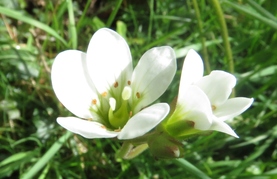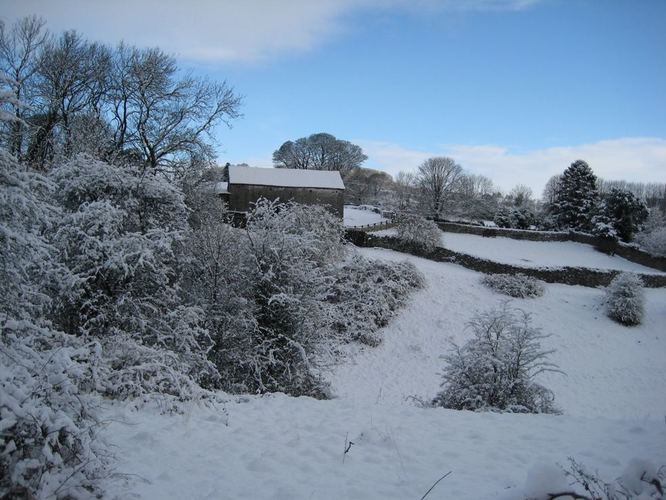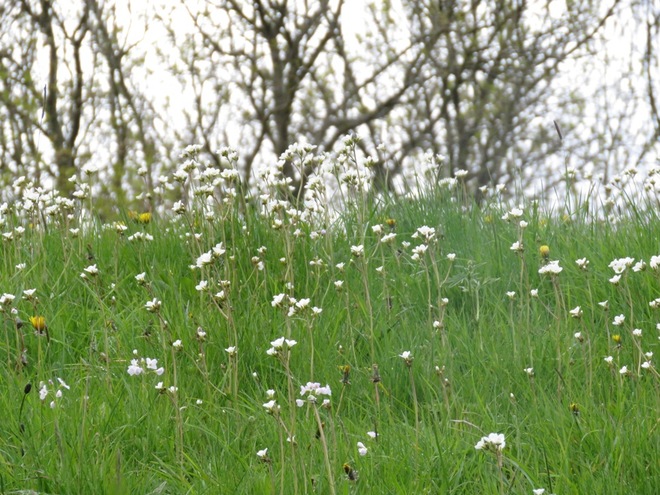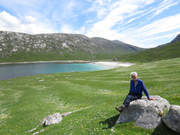 Meadow saxifrage, Saxifraga granulata
Meadow saxifrage, Saxifraga granulata For tourists, walkers and runners heading for Scout Scar, Ghyll Brow is a delight. In presenting a floral tribute to Ghyll Brow I’m recording a point in time. Change is certain, significant change .
Easter Sunday was glorious, with blue skies and a lightness of new-fallen snow that transfigures the trees in a rare and transient effect . The beauty of it would not last the morning.. This winter scene features in About Scout Scar. My book will read differently as Ghyll Brow changes, as the town reaches out around it.
Countryside begins here, that’s how it feels . Hardly anyone goes down into the Ghyll, why would they? It isn’t access land and sunlight scarcely penetrates through the trees and limestone crags. Sheltered and inaccessible, its mature trees are cloaked in ivy, ideal for hibernating bats and invertebrates, a shelter for roosting birds. Seeing kestrel mating is a once-in-a-lifetime experience and I saw it here. I came each day to watch the fledgling take its first flight.
Ghyll Brow is a wildlife corridor. But not for much longer. The Ghyll itself is too rugged, too steep to build on. But expect to see houses following the barn and the wall aligned with it. We locals have asked that barn, trees and walls be retained. I asked that trees be planted along the wall to mask the houses and retain something of the rural character of Ghyll Brow. I asked for habitat surveys. There were development briefs and consultations but their remit on biodiversity was to look exclusively at the sites allocated for building. Biodiversity is all around especially on Scout Scar and we were told repeatedly that that was no’t up for discussion. It’s the impact on the surrounding countryside that needs to be addressed.
Locals are concerned about where access to the Stainbank Green development will be. The existing road to Stainbank Green curves gently into the Brigsteer Road on level ground above Ghyll Brow. We all assumed that would be the chosen access. In October 2014 we were shown a map with a new road cutting through the meadow saxifrage pastures at the steepest point. Farewell meadow saxifrage. If you’ve ever stood and watched the Brigsteer Road turning into a watercourse during downpours then think of that new road as a tributary. In winter, ice is frequently a problem where the road climbs steeply. Locals have made the point over and over. It is known. They tell of a winter a milk lorry went sliding back down the road.
Watch this space. I mean the Ghyll Brow space. Ghyll Brow is remarkable in itself, and its proximity to Scout Scar is an added dimension. What happens here and now has importance for the future. It’s about the value we place on countryside and all that it means to us. And about the wildlife experience we want to hand on to coming generations.
Ghyll Brow: a pastoral elegy was written to complement a March 11th presentation to Kendal U3A Natural History group . Three days later, friends began to draw my attention to a piece in The Westmorland Gazette. Story Homes first development of 35 houses at Stainbank Green had been refused planning permission because of unacceptable environmental damage. Cutting a road through those pastures at their steepest point would wholly change the character of the landscape and the proposed density of houses was turned down.
In May 2015, we received the latest Development Briefs. Access proposed via the existing road to Stainbank Green.
I continue to photograph the flora of the wayside verge through spring, and to post images. What I'm recording is a snapshot in time, how it is in spring and summer 2015. I'd rather this was not an elegy. What I would like to achieve is to protect the character and the quality of Ghyll Brow and to be able to show new residents a wonderful roadside verge and pastures of meadow saxifrage.



 RSS Feed
RSS Feed